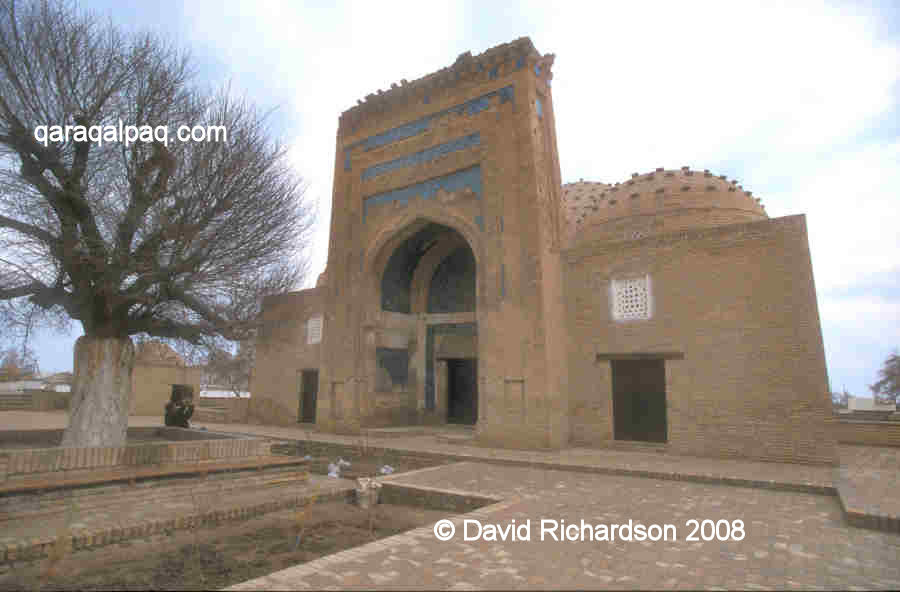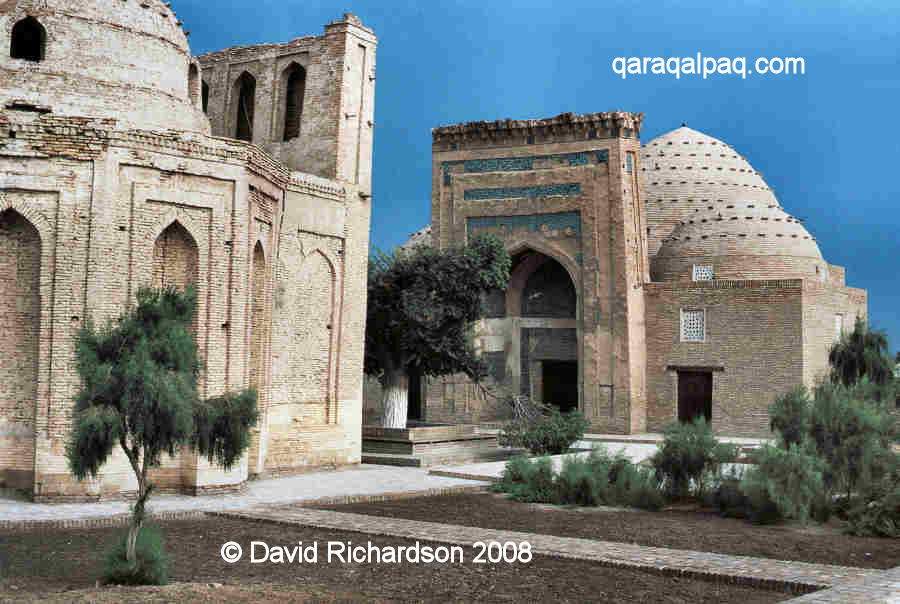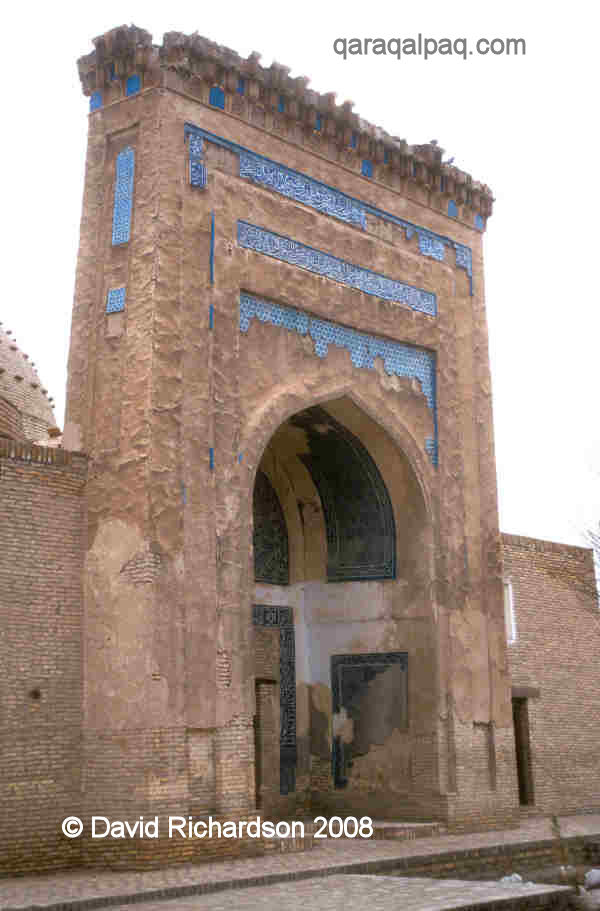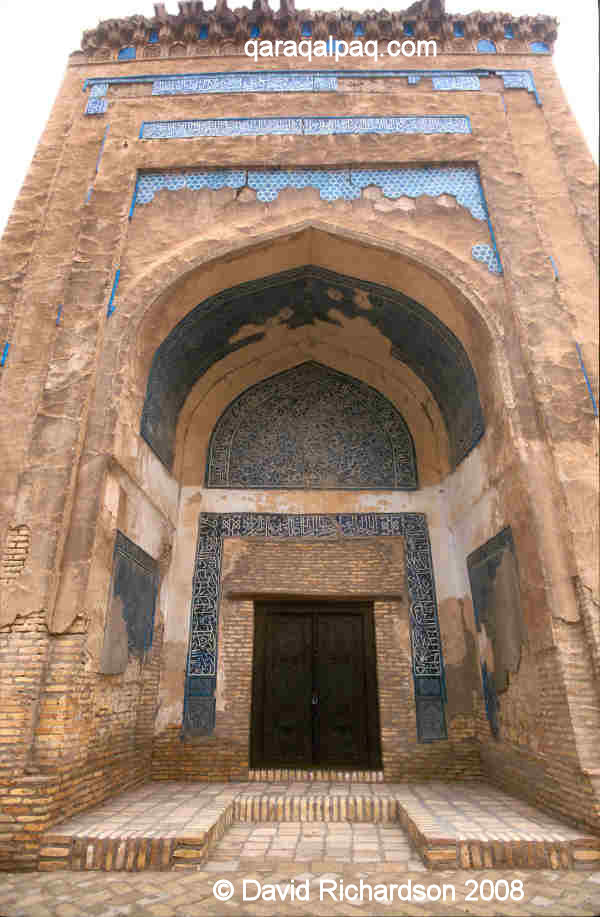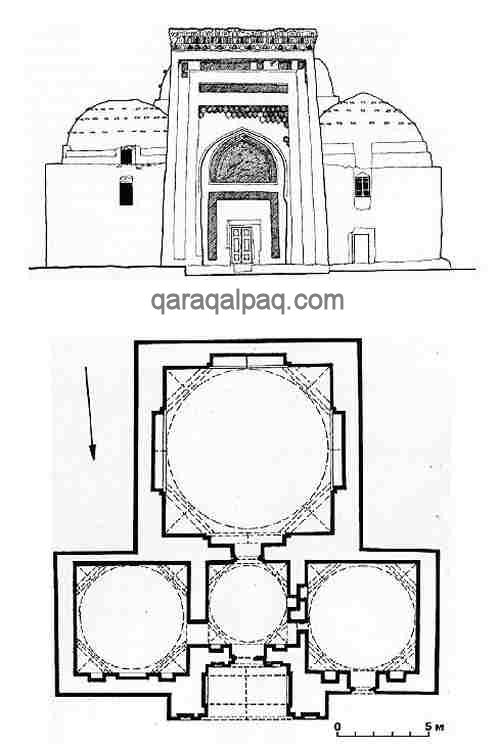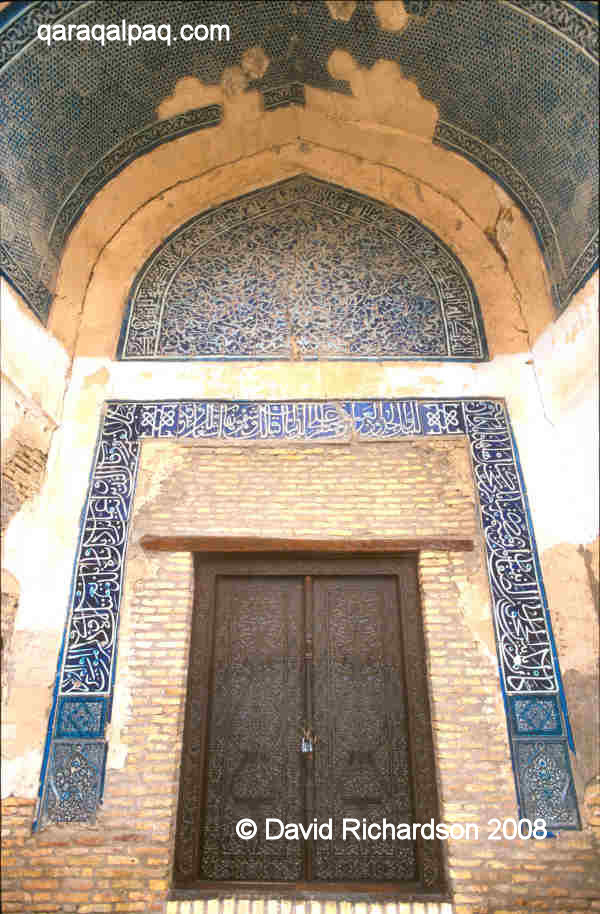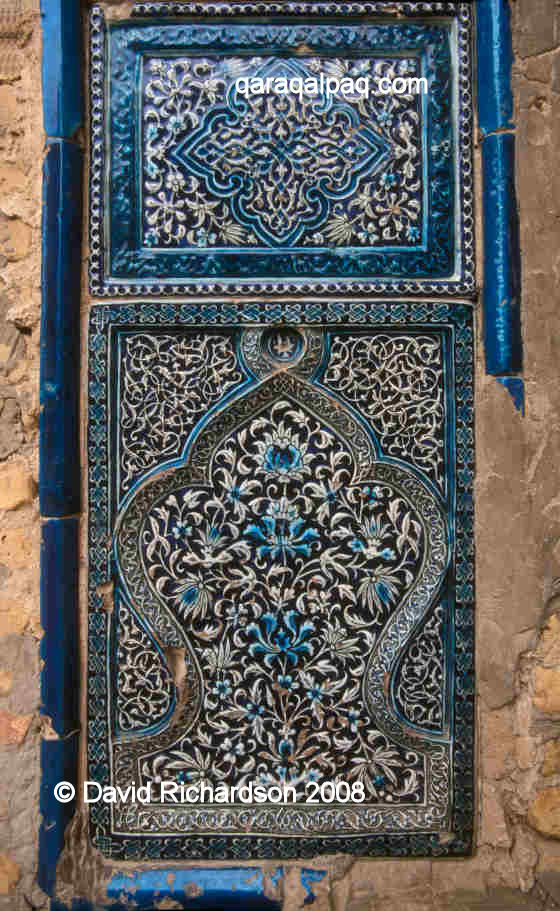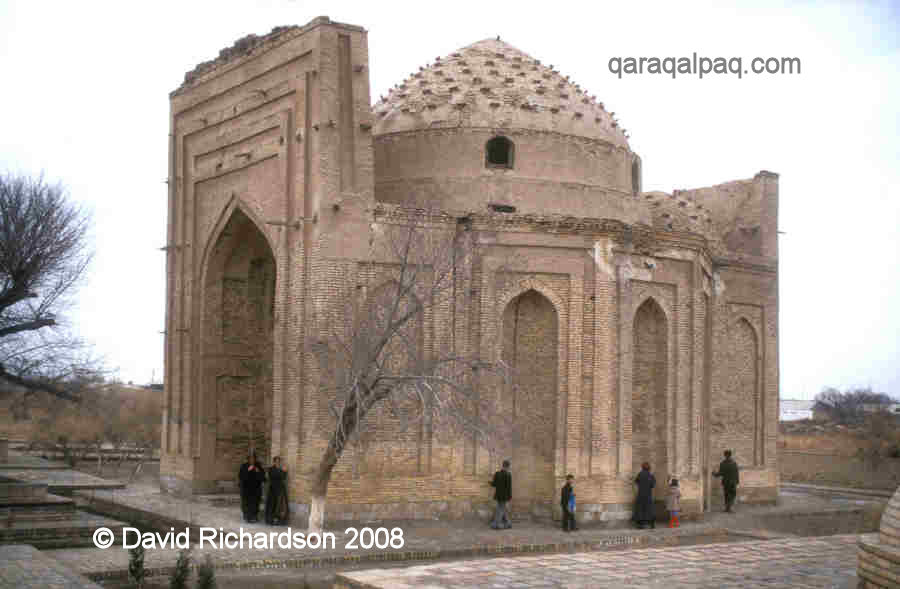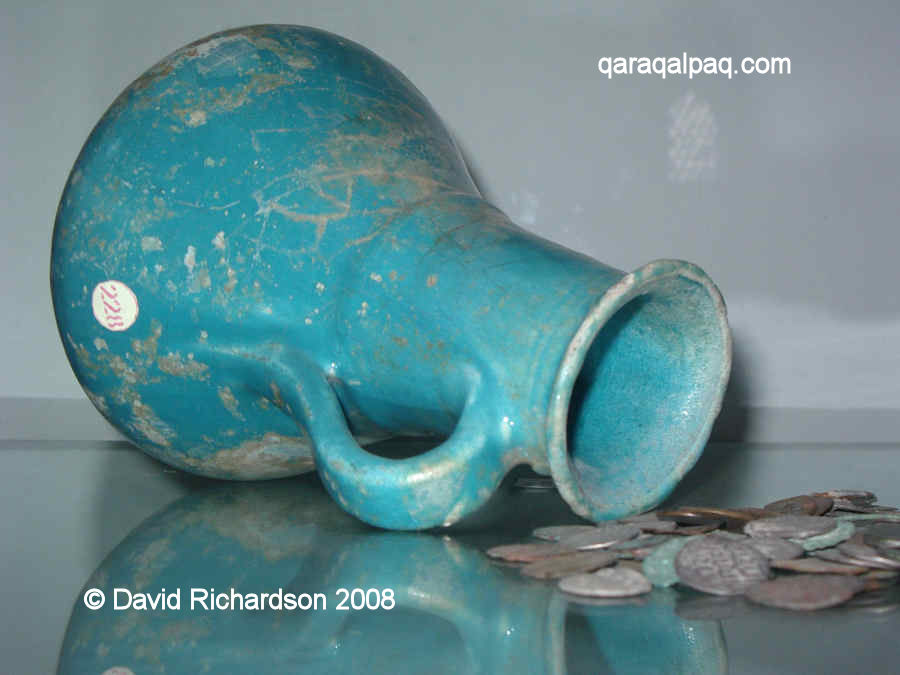|
Location
The Najm al-Din Kubra mausoleum is located in the centre of Kunya Urgench, just south of the Khan-yab canal. It is built in a pretty little walled
courtyard with spreading trees located in the centre of a large open area just west of the Dash mosque and medresseh, which today houses a small
local museum. The courtyard also contains the mausoleum of Sultan Ali.
Satellite image of the Dash mosque and medresseh on the right and the walled courtyard on the left.
The Najm al-Din Kubra mausoleum lies to the south of the smaller Sultan Ali mausoleum. Image courtesy of Google Earth.
Najm ad-Din Kubra mausoleum
The mausoleum of Najm ad-Din Kubra is oriented north-south with its entrance on the northern side. The building is dominated by a 12 metre high
portal or pishtaq, whose doors open into a small twin-domed entry vestibule, flanked on each side with square rooms. The latter have a single
domed ceiling and their own separate entry doors on each side of the central portal. The entry vestibule leads into the main burial chamber, which
has squinches in each of the four upper corners and is roofed with a large open octagonal drum. The walls are decorated with large arched niches. The
whole interior is illuminated by small screened windows set in the walls as well as in the domes of the roof.
The Najm al-Din mausoleum. Note the restored roof domes and two side rooms.
The burial chamber contains the rectangular double sarcophagus of Najm al-Din Kubra in its north-western corner, next to a smaller rectangular shrine.
Legend has it that Kubra was beheaded by the Mongols during the conquest of Gurganj and that one sarcophagus contains his body and the other his head.
From the evidence of old photographs it seems that the sarcophagus was originally covered with blue glazed tiles and inscriptions. Today all that
remains are the words El Mulku-lillah meaning "all things are God's".
The Najm al-Din mausoleum, facing the Sultan Ali mausoleum.
There are similarities to the mausoleum of the Nakshbandi Sufi khoja Sayid 'Ala ad-Din at nearby Khiva. His tomb, which was built around 1340
and restored in the 1990s, is decorated with blue, green and turquoise majolica tiles. It is one of the oldest buildings in the Ichan qala.
The tiled portal of the Najm al-Din Kubra mausoleum.
The Najm ad-Din Kubra mausoleum was constructed from thin yellow fired bricks and the domed roofs are rounded on the outside. The portal is in a bad
state of disrepair, with much of the brickwork covered in cracked cement render. Apparently the monument was partly restored in 1950 following the
collapse of the central dome. Much of the original blue glazed tile work on the portal is missing. The two rows of tiles decorated with Kufic script
along the top of the portal apparently praise Qutlugh Timur, the governor of Golden Horde Khorezm from 1321 to 1333, who patronized the building of the
mausoleum. The facing of the portal around the arched entrance was once covered with simple hexagonal tiles, only the top rows of which remain. The
best preserved tile work is over and around the replica wooden entrance door. The original doors are kept inside the mausoleum.
Drawing of the Najm al-Din mausoleum by I. I. Notkin, 1959.
Najm al-din Kubra was born in Khiva in 1145, when the Qipchaq armies of Khorezm ruled over a large part of western Central Asia. After his basic
education in Islam he moved to Dizful in western Persia to continue his religious studies. After the death of his second teacher he moved to Egypt
to continue his education and to become a religious teacher. During his stay he married the daughter of his own religious instructor. He seems to have
returned to Khorezm at some time between 1185 and 1190, establishing his own school of Sufi mysticism, which became known as the Kubra order.
Decorative tilework around the main door.
Najm ad-Din Kubra helped Khorezm become one of the major centres of Sufism during the 12th to the 14th centuries. Sufism is a mystical, spiritual and
emotional branch of Islam, which aims for its adherents to reach God through personal meditation and secret recitation. The Sufi movement originally
developed in Iraq and Syria in the early 9th century before spreading into western Central Asia. The movement's name derives from suf, meaning
wool, since the Sufis wore simple cloaks made from coarse wool. Najm ad-Din Kubra taught his pupils that they must become more Godly by personally
undertaking a series of ascetic practices involving fasting, prayer and silent meditation under the supervision of a master. In time the pupil would
progress from one spiritual stage to another, each symbolized by different colours; black corresponded to the lowest stage and green to the highest.
Glazed tilework panel on the side of the entrance doorway.
Najm al-Din Kubra wrote extensively and seven of his books and 24 of his poems survive to this day. His most important book was Fawatih al-Jamal
wa fawatih al-jalal, or the "Aromas of Beauty and Preambles of Majesty", where he recorded his own personal visionary experiences along with
detailed guidance for students of his Sufi doctrine. In this book he described the details of the coloured lights and spots that appear when a novice
undergoes spiritual training and how even the act of breathing expresses obedience to God, since the sound of exhalation and inhalation – "ha" –
signifies Allah. His brand of Sufism, which became known as the Kubrawiyyah Order, was rapidly introduced to Persia, Afghanistan, India and
China.
At the time of Chinggis Khan's invasion of Khorezm in 1221, Najm ad-Din Kubra was already 75 years old. Legend has it that the Mongols offered him
the chance to surrender before the siege of Gurganj. He refused and fought alongside his fellow Khorezmians, only to be beheaded after its conquest.
His mausoleum was constructed over one hundred years later under the orders of Qutlugh Timur (a name meaning "blessed iron"), who had been appointed
governor of Khorezm by Sultan Uzbeg, the ruler of the Golden Horde. Qutlugh Timur happened to be the son of Uzbeg's maternal aunt.
It is not clear whether the mausoleum truly does contain the remains of Najm ad-Din Kubra. Nevertheless it still remains the most holy place in the
Kunya Urgench region and attracts many local pilgrims.
Sultan Ali mausoleum
Just opposite the Najm ad-Din Kubra mausoleum is a later 16th century mausoleum built for Ali Khan, who was commonly called Sultan Ali. He was the son
of the Khorezmian ruler Avanesh Khan (1535-38) and was appointed governor of Urgench (Kunya Urgench, not modern day Urgench) by the later Aqatay Khan
(1548-1556). Aqatay Khan was one of Avanesh Khan's younger brothers.
The Sultan Ali mausoleum.
Sultan Ali was visited by the English merchant Anthony Jenkinson when he travelled through Urgench in 1558. This was a time of an intense power
struggle between the ruling families of Khorezm. Jenkinson noted that although one of them had the name of king or Khan:
" ... he is little obeyed saving in his own dominion, and where he dwelleth: for every one will be king of his own portion, and one brother will
seeketh always to destroy another, having no natural love among them, by reason that they are begotten of divers women, and commonly they are the
children of slaves, either Christian or Gentiles, which the father doeth keep as concubines, and every Khan and Sultan hath at least 4 or 5 wives,
besides young maidens and boys, living most viciously ..."
Urgench was essentially in the middle of a civil war and Jenkinson observed that the town had been won and lost four times within the past seven years!
The Sultan Ali mausoleum was built in the 1580s. It is a miniature copy of the Tura beg Khanum mausoleum, located on the edge of the ruins of Urgench
just south of Kunya Urgench. However unlike the original, the copy has been built in simple yellow fired brick and has no decorative tile work whatsoever.
This lack of decoration was probably a sign of the times. All of Khorezm's master craftsmen had been long ago enslaved by Amir Timur and marched off
to build the palaces, mosques and medressehs of Samarkand and Shahr-i Sabz.
Dash mosque and medressah
The Dash mosque and medresseh is just a minute's walk away from the mausoleums of Najm ad-Din Kubra and Sultan Ali. It was built in 1908 and consists
of a number of domed cells with doors overlooking a courtyard.
Today it houses the local Kunya Urgench museum and is well worth a visit although there is a small admission charge. The museum contains various
archaeological finds from the sites of Kunya Urgench, including some interesting examples of 12th century and Golden Horde tiles and ceramics and
information on some of the monumental qalas in the surrounding region. Look out for the blue polished vase excavated from the Sultan Tekesh
mausoleum that contained a horde of 500 silver coins.
The horde of silver coins.
Google Earth Coordinates
The following reference points (in degrees and digital minutes) will enable you to locate the two mausoleums on Google Earth:
| | Google Earth Coordinates |
|---|
| Place | Latitude North | Longitude East |
|---|
| Najm ad-Din Kubra mausoleum | 42º 19.545 | 59º 8.762 |
| Sultan Ali mausoleum | 42º 19.564 | 59º 8.768 |
| | | |
Note that these are not GPS measurements taken on the ground.
Return to top of page
Home Page
|


